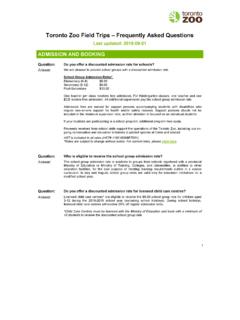Transcription of a conservation guide - Toronto Zoo
1 Bats a conservation guide ats are perhaps the most misunderstood animals on Earth yet they play vital roles in many of the planet's ecosystems. The goal of the Toronto Zoo's Bat conservation Programme is to educate people about the importance of bats and to eliminate the misconceptions that contribute to negative human views and actions towards these animals. We also hope that this booklet will encourage people to accept the bats living in or near their homes. Although it is preferable to leave bats to their traditional roosts, we can offer bats alternative housing by installing a bat box. Bat boxes are not meant to encourage the eviction of bats from existing locations, but offer temporary housing when available roosting sites are few or after they have been evicted from their present location.
2 Toronto Zoo 361A Old Finch Avenue Scarborough, Ontario M1B 5K7. (416) 392-5929. 1. Bats first took to the skies over 50 million years ago yet today's bats are virtually indistinguishable from their ancient ancestors. Their wings and their ability to fly seperate bats from other mammals, but even among the world's bats there is great physical variation. Bats truly are a unique and striking group of animals. Bats come in a wide range of sizes, from the kg golden-crowned flying fox (right) to the 2 g bumblebee bat (left). Over 70% of bats are insectivorous but many others consume fruit, nectar and pollen. A few species feast on fish, frogs, flowers, and leaves. There are even three bat species, the vampire bats, which survive solely on the blood of other animals.
3 Don't be alarmed though . vampire bats much prefer the blood of cattle and horses to that of sleeping humans! 2. Threatened, not Threatening Misconceptions have played a primary role in the persecution of bats. These animals are often thought of as blind, rabies-infested, blood-sucking monsters. In reality, bats are gentle, beneficial and interesting creatures that unnecessarily suffer due to our fears and unfounded beliefs. With the exception of the Antarctic, bats inhabit all regions of Earth. With over 1,200 species worldwide it's no wonder that bats are of great ecological importance. Insectivorous bats often keep insect populations in check while bats that feed on fruits and nectar disperse seeds and pollinate flowers in a wide range of ecosystems, from rainforests to deserts.
4 Eastern Canada is home to eight species of insectivorous bats, three of which are endangered. The destruction of bat roosts, pesticide use, and habitat destruction have all contributed to bat population declines in Canada. However, a deadly fungal disease, White Nose Syndrome, is currently the most serious threat to our bats. 3. Eastern Canadian Bats Big brown bat (Eptesicus fuscus). Fur ranges from tan to dark brown. Communal roosts can contain up to 700 bats. Inhabits forested areas and often roosts under tree bark, in hollow trees, rock crevices, and man-made structures such as cabins and barns. Widely distributed in southern Canada from to New Brunswick. Hibernates in caves and mines. Wingspan: 28-33 cm, Length: 11-13 cm, Weight: 14-25 g Northern long-eared bat (Myotis septentrionalis).
5 Fur is dull, yellow-brown. Large, black ears extend beyond tip of nose. Solitary. Prefers boreal forest habitat and roosts under bark, in tree cavities and in buildings. Distributed from the eastern Rockies through south and central Ontario, southern Quebec, and the Maritimes. Hibernates in caves and mines. Wingspan: 23-26 cm, Length: 6-10 cm, Weight: 6-9 g Little brown bat (Myotis lucifugus). Fur is uniformly glossy brown. Communal roosts can include thousands of bats. Inhabits a wide range of habitats. Roost sites include buildings, trees, wood piles and caves. Widespread throughout Canada. Hibernates in caves and mines. Wingspan: 22-27 cm, Length: 6-10 cm, Weight: 5-14 g Eastern Small-footed bat (Myotis leibii).
6 Fur is glossy, golden brown. Feet small in comparison to other Canadian bats. Roosts communally with 10-30 individuals. Prefers forested habitat with hilly terrain. Roosts in hollow trees, under bark, and on buildings, cliffs and bridges. Found only in southern Ontario and Quebec. Hibernates in caves and mines. Wingspan: 21-25 cm, Length: 7-9 cm, Weight: 3-6 g 4. Silver-haired bat (Lasionycteris noctivagans). Heavily-furred bat species. Fur is predominantly black or dark brown but hairs on its back have white tips, giving it a silver or frosted appearance. Solitary. Primarily inhabits forested areas and roosts under loose tree bark, but can also be found in urban and rural areas. Widely distributed in southern Canada from to eastern Nova Scotia.
7 Migratory. Wingspan: 27-31 cm, Length: 9-11 cm, Weight: 8-12 g Eastern red bat (Lasiurus borealis). Fur colour ranges from yellow-red to orange to yellow-grey. Solitary. Inhabits forested areas and nearby grasslands. Roosts in dense tree foliage. Distributed in southern Ontario, Quebec, New Brunswick and in parts of Nova Scotia. Migratory. Wingspan: 27-33 cm, Length: 9-12 cm, Weight: 7-13 g Hoary bat (Lasiurus cinereus). Canada's largest bat. Fur is long, thick, and mostly black. Fur on back and tail is brown-grey with white tips. Distinct yellowish fur on head and throat. Solitary. Preferred roosts include dense tree foliage on the edges of clearings. common and widespread in Canada east of the Rockies. Migratory.
8 Wingspan: 34-43 cm, Length: 13-15 cm, Weight: 20-35 g Tricoloured bat (Perimyotis sub avus). Also known as the Eastern Pipistrelle. Fur appears brown-yellow but individual hairs are tricoloured - dark grey base, yellowish middle, dark brown tips. Roosts communally. Inhabit open woodlands near bodies of water and roost in rock crevices, caves, trees and buildings. Distributed in southern Ontario, Quebec, New Brunswick and in parts of Nova Scotia. Hibernates in caves and mines. Wingspan: 19-26 cm, Length: 7-9 cm, Weight: 4-8 g 5. Bat Attitudes common Misconceptions Bats are not Mice! As a matter of fact, bats are more closely related to humans than to rodents. Bats are mammals and therefore share many common characteristics with both humans and mice.
9 Bats have fur, give birth to live young, and feed their newborns milk until they are old enough to find food for themselves. Bats belong to the order Chiroptera, which means hand-wing . Their wings are much the same as human hands, with a thumb and four fingers, except their digits are connected by a double layer of skin. Although a bat's hand is very large in proportion to its body, it contains the same number of bones as a human hand. No Need to Duck Insects often hover around people and a hungry bat might swoop down in hot pursuit of a meal. But don't worry, a bat's sonar ability is so sophisticated that it can detect objects smaller than a human hair and intercept those objects at speeds greater than 30 km/h.
10 Bats are far too agile to get caught in someone's hair. 6. Blind as a Bat All bats can see. Some can see very well. Flying foxes (types of fruit bats) have excellent vision and use it with their acute sense of smell to locate ripe and juicy fruit. Most bats also have the ability to echolocate, or use sound to "see". Because bats hunt at night when it is dark, this biological form of sonar is essential for locating prey. Bats emit sound pulses that bounce off objects and return as echoes. The returning sound waves tell the bat where the object is, how large it is, and how fast it is moving. Did You Bats are the primary predators of nocturnal, ying insects and play a vital role in limiting their numbers. A single little brown bat is capable of eating its own body weight in insects in a single night up to 600 bugs per hour!









